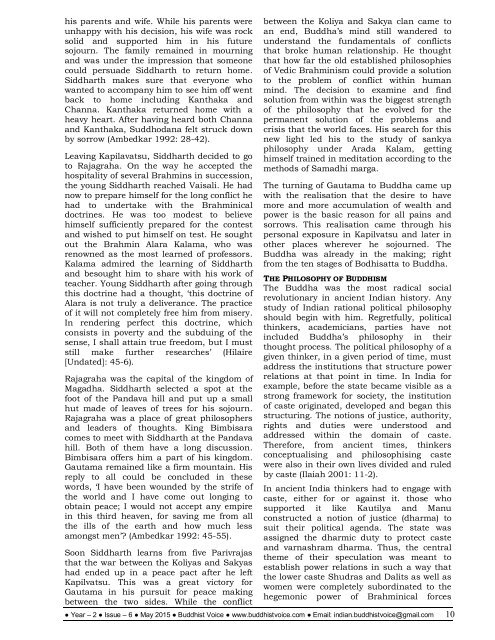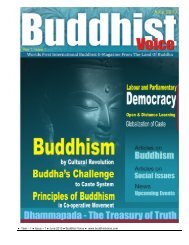BV - May 2015 Yr 2 Issue 6 E
Create successful ePaper yourself
Turn your PDF publications into a flip-book with our unique Google optimized e-Paper software.
his parents and wife. While his parents were<br />
unhappy with his decision, his wife was rock<br />
solid and supported him in his future<br />
sojourn. The family remained in mourning<br />
and was under the impression that someone<br />
could persuade Siddharth to return home.<br />
Siddharth makes sure that everyone who<br />
wanted to accompany him to see him off went<br />
back to home including Kanthaka and<br />
Channa. Kanthaka returned home with a<br />
heavy heart. After having heard both Channa<br />
and Kanthaka, Suddhodana felt struck down<br />
by sorrow (Ambedkar 1992: 28-42).<br />
Leaving Kapilavatsu, Siddharth decided to go<br />
to Rajagraha. On the way he accepted the<br />
hospitality of several Brahmins in succession,<br />
the young Siddharth reached Vaisali. He had<br />
now to prepare himself for the long conflict he<br />
had to undertake with the Brahminical<br />
doctrines. He was too modest to believe<br />
himself sufficiently prepared for the contest<br />
and wished to put himself on test. He sought<br />
out the Brahmin Alara Kalama, who was<br />
renowned as the most learned of professors.<br />
Kalama admired the learning of Siddharth<br />
and besought him to share with his work of<br />
teacher. Young Siddharth after going through<br />
this doctrine had a thought, ‘this doctrine of<br />
Alara is not truly a deliverance. The practice<br />
of it will not completely free him from misery.<br />
In rendering perfect this doctrine, which<br />
consists in poverty and the subduing of the<br />
sense, I shall attain true freedom, but I must<br />
still make further researches’ (Hilaire<br />
[Undated]: 45-6).<br />
Rajagraha was the capital of the kingdom of<br />
Magadha. Siddharth selected a spot at the<br />
foot of the Pandava hill and put up a small<br />
hut made of leaves of trees for his sojourn.<br />
Rajagraha was a place of great philosophers<br />
and leaders of thoughts. King Bimbisara<br />
comes to meet with Siddharth at the Pandava<br />
hill. Both of them have a long discussion.<br />
Bimbisara offers him a part of his kingdom.<br />
Gautama remained like a firm mountain. His<br />
reply to all could be concluded in these<br />
words, ‘I have been wounded by the strife of<br />
the world and I have come out longing to<br />
obtain peace; I would not accept any empire<br />
in this third heaven, for saving me from all<br />
the ills of the earth and how much less<br />
amongst men’? (Ambedkar 1992: 45-55).<br />
Soon Siddharth learns from five Parivrajas<br />
that the war between the Koliyas and Sakyas<br />
had ended up in a peace pact after he left<br />
Kapilvatsu. This was a great victory for<br />
Gautama in his pursuit for peace making<br />
between the two sides. While the conflict<br />
between the Koliya and Sakya clan came to<br />
an end, Buddha’s mind still wandered to<br />
understand the fundamentals of conflicts<br />
that broke human relationship. He thought<br />
that how far the old established philosophies<br />
of Vedic Brahminism could provide a solution<br />
to the problem of conflict within human<br />
mind. The decision to examine and find<br />
solution from within was the biggest strength<br />
of the philosophy that he evolved for the<br />
permanent solution of the problems and<br />
crisis that the world faces. His search for this<br />
new light led his to the study of sankya<br />
philosophy under Arada Kalam, getting<br />
himself trained in meditation according to the<br />
methods of Samadhi marga.<br />
The turning of Gautama to Buddha came up<br />
with the realisation that the desire to have<br />
more and more accumulation of wealth and<br />
power is the basic reason for all pains and<br />
sorrows. This realisation came through his<br />
personal exposure in Kapilvatsu and later in<br />
other places wherever he sojourned. The<br />
Buddha was already in the making; right<br />
from the ten stages of Bodhisatta to Buddha.<br />
THE PHILOSOPHY OF BUDDHISM<br />
The Buddha was the most radical social<br />
revolutionary in ancient Indian history. Any<br />
study of Indian rational political philosophy<br />
should begin with him. Regretfully, political<br />
thinkers, academicians, parties have not<br />
included Buddha’s philosophy in their<br />
thought process. The political philosophy of a<br />
given thinker, in a given period of time, must<br />
address the institutions that structure power<br />
relations at that point in time. In India for<br />
example, before the state became visible as a<br />
strong framework for society, the institution<br />
of caste originated, developed and began this<br />
structuring. The notions of justice, authority,<br />
rights and duties were understood and<br />
addressed within the domain of caste.<br />
Therefore, from ancient times, thinkers<br />
conceptualising and philosophising caste<br />
were also in their own lives divided and ruled<br />
by caste (Ilaiah 2001: 11-2).<br />
In ancient India thinkers had to engage with<br />
caste, either for or against it. those who<br />
supported it like Kautilya and Manu<br />
constructed a notion of justice (dharma) to<br />
suit their political agenda. The state was<br />
assigned the dharmic duty to protect caste<br />
and varnashram dharma. Thus, the central<br />
theme of their speculation was meant to<br />
establish power relations in such a way that<br />
the lower caste Shudras and Dalits as well as<br />
women were completely subordinated to the<br />
hegemonic power of Brahminical forces<br />
● Year – 2 ● <strong>Issue</strong> – 6 ● <strong>May</strong> <strong>2015</strong> ● Buddhist Voice ● www.buddhistvoice.com ● Email: indian.buddhistvoice@gmail.com 10



